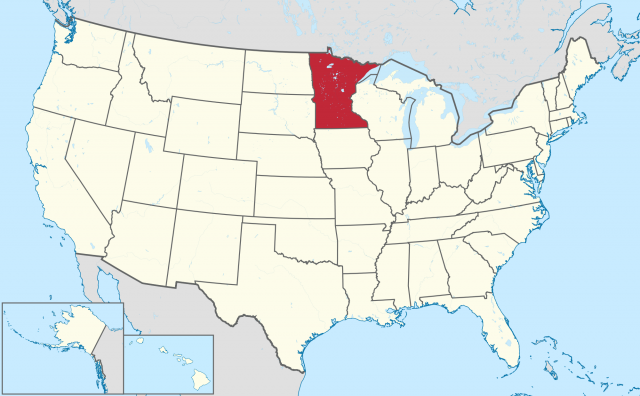Minnesota
WITH THE EXCEPTION of ALASKA, Minnesota is the northernmost U.S. state, on account of the notch in its northern border, where Lake of the Woods abuts CANADA. Long known as the “Land of 10,000 Lakes,” the state is also known for its progressive society, common Scandinavian heritage, sturdy agriculture, advanced technology, and outdoor tourism. Minnesota has a population of 5,019,720 (2002) and covers an area of 86,943 square mi (225,182 square km). Minnesota officially entered the Union in 1858.
The landscape of Minnesota was carved out by the glacial action of the last Ice Age. This glacial erosion left considerable areas of gently rolling hills. It also scooped out lowlands that filled with water, and melted ice, thereby creating the ubiquitous lakes of Minnesota. Depending on how size is used to define “lake,” there actually are some 11,000–15,000 lakes in the state. The preponderance of water in the state is striking, especially in the north. When viewed from above in an airplane, the state can appear to be more water than land.

The glacial retreat of the ice age also deposited a thick layer of fertile soil across the lands of Minnesota. Combined with warm summers and typically ample rainfall (a humid continental climate classification), Minnesota is blessed with an excellent agricultural setting. Minnesota is among the country's leading producers of corn, soybeans, livestock, and wheat. Many small towns and villages dot the landscape, acting as agricultural centers of activity amid a mixture of family farms. With a significant share of its land still forested, the state is a major producer of wood and forest products, with about 60,000 people employed in the industry. Historically, the timber industry was epic, featuring the folklore tales of Paul Bunyan and his blue ox Babe, statues of whom can be seen in the northern city of Bemidji.
The land also holds minerals. The Mesabi Range in northern Minnesota has for years produced a wealth of iron ore. Even as some of the richest veins of ore were emptied, extraction of lesser-grade ore (taconite) has continued. Residents of the Iron Range gained income directly and indirectly from the wealth brought in by the ore. Vast quantities of iron ore were shipped out of Duluth harbor, across Lake Superior, and on to steel mills in states such as PENNSYLVANIA. Even wind serves as a resource over the land, with high-tech windmills on wind farms in southwestern Minnesota.
The lakes and forests of Minnesota serve as magnets for tourism. Some 3 million people use Minnesota sites for recreation each year. Lakes provide thousands of settings for swimming, fishing, boating, and water skiing. Even in winter, recreational activity is prominent in the state; snowmobiling, ice fishing, and cross – country skiing are among the activities.
The eastern half of Minnesota's land was acquired from the British upon the American victory in the Revolutionary War. The vast LOUISIANA PURCHASE of 1803 included the western portion, with a small northern strip acquired from Britain in 1818. Numerous place names recall the original native presence in the region. Native American tribes were progressively pushed from their lands, eventually resettling in several reservations, mainly in northern areas. As in several states, some of these tribes built and currently manage gambling casinos.
Although Minnesota features a population of diverse origins, there is a clear imbalance in numbers toward those of Scandinavian origin. Migrants from NORWAY and SWEDEN came to the UNITED STATES in large numbers, particularly in the late 1800s and early 1900s. Their descendants are still there: Several Minnesota counties in the northwest have over 80 percent Norwegian heritage. Approximately half of the state's 5 million people reside in the broad Twin Cities (Minneapolis-St. Paul) metro area. While Minneapolis is the larger of the paired cities, the state capital is St. Paul. A friendly rivalry exists between the two cities, as well as between “the Cities” and the out-state areas. Politically, the state has long displayed progressive tendencies and has sent forth prominent figures such as U.S. vice presidents Hubert Humphrey and Walter Mondale.
The Twin Cities also serve as the state's economic core. Amid substantial manufacturing and service sector production, several national companies (General Mills, Honeywell, Northwest Airlines, Pillsbury, and 3M) base their headquarters there. The Mall of America in suburban Bloomington is the country's largest indoor shopping center and attracts shoppers from great distances. An hour south of the Twin Cities, Rochester is dominated by the medical industry, featuring the internationally renowned Mayo Clinic.